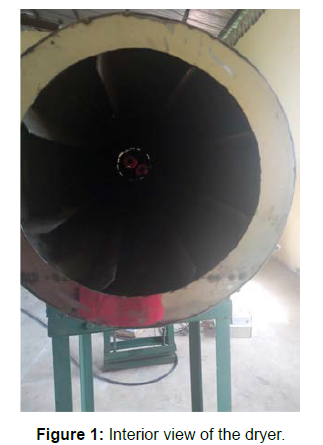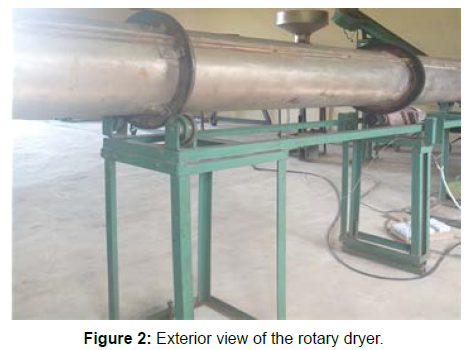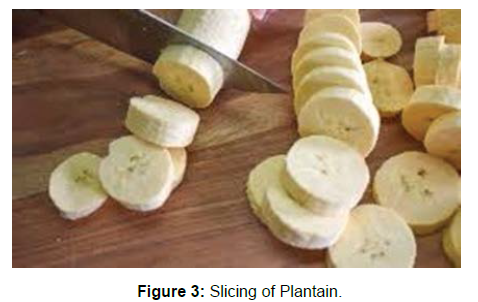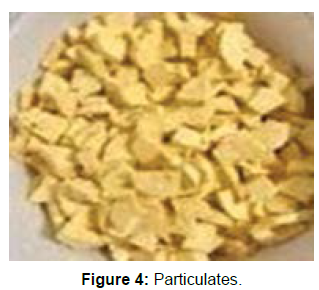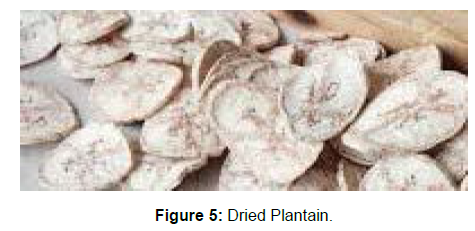Performance Evaluation And Efficiency Optimization Of Olumitomilola's Rotary Dryer: A Machine Design For Plantain Processing Plant
Received: 21-Oct-2021 / Accepted Date: 04-Nov-2021 / Published Date: 11-Nov-2021 DOI: 10.4172/2576-1463.1000252
Abstract
The process of making plantain flour from plantain (Musa paradisiaca), which is mostly consumed in the tropical region, can be time-consuming. Through the years, various methods of processing the plantain pulps into flour have been devised, each having its own limitations and advantages. Although there is an existing market for the design and production of plantain processing plant, proper drying, one of the most important stages in the production of plantain flour to remove moisture from plantain pulps (sliced or particulate), still remains a challenge to effective food processing plants. The performance evaluation of an effective dryer that will dry and allow the movement of dried plantain pulps to the next machine in a plantain process plant and its suitability to the food industrial applications was carried out in this study. The volume of the drying drum was estimated to be 0.03 m3. The capacity of the dryer is the amount of plantain the drying drum can contain per batch. 29 kg of plantain pulps was dried at a temperature of 70°C for 27 to 29 minutes. The efficiency of the machine was evaluated to be 72.7% by estimating the moisture removal rate from the plantain in comparison with the power consumption rate. The rotary dryer was developed by Dr. Olutomilola of the department mechanical engineering, Federal University of Technology Akure. The dryer was modified and its overall drying efficiency was optimized by +18.01%.
Keywords
Food Security; Food Processing; Performance Evaluation; Design Optimization
Introduction
Plantain (Musa paradisiaca) is a staple food in the tropical regions of the world, ranking as the tenth most important staple food in the world [1]. It is majorly cultivated in West and Central Africa, the Caribbean islands, Central America, northern America and coastal parts of South America. It contains 32% carbohydrates with 2% dietary fiber, 15% sugars, 1% protein, 0.4% fat and 65% water, supplying 122 calories in a 100-gram serving [1]. According to Treche 69.4% of plantains and other cooking bananas are used for human consumption while 8.0% are used for animal feed [2]. Post-harvest losses and transformed quantities in the world are 11.5% and 11%, respectively. In most cases plantains are locally consumed. Plantain also shows great adaptation to urban consumption and exportation to specific markets. This will vary from one country to another because of prevailing eating habits. Research has been carried out on how to increase the life span of these produce and this has led to the discovery of various processes of converting the agricultural products to semi-finished and finished goods to facilitate easy storage and eradicate the problem of wastage.
According to Hodge [3] one way to preserve plantains is to refrigerate them as they will not ripen once refrigerated. Other ways of preservation are roasting, sun drying etc. But research has discovered that these methods of preservation are not 100% efficient as the plantain is prone to attack from pests and certain diseases that significantly affect fruit qualities. Good disease control can be achieved with fungicides belonging to triazole and benzimidazole groups. As costs continue to rise, the need for resistant hybrids becomes imperative. Cultural practices used to control such diseases include good drainage [4] and frequently stripping off the leaves with necrotic tissues. Some fungi are responsible for post-harvest diseases, which affect the quality of the banana and plantain fruits. For example, anthracnose caused by Colletotricum musae provokes the decay of fruits during ripening. Incidence of anthracnose may be reduced by removal of inoculum laden banana and plantain trash from packing areas and by avoiding injury to fingers and pedicels during harvesting and packing [4].
Also, the plantains are exposed to harsh weather conditions using local methods of drying which will lead to the loss of 50% of the fruits nutrients before consumption. These and many other factors have led to the search for a more hygienic, effective and stress-free method of preserving and processing the plantain.
Rotary dryer is an electrically-powered machine employed to reduce the moisture content of the material by subjecting it to heated gas while the cooling conveyor cools and transports the cooled products to the final point of packaging. It has the function of removing the moisture of the organic material into a more usable, desirable product. Rotary dryer is indispensable equipment in every drying industry and every industry that deals with processing of agricultural produce to semifinished and finished products, respectively. Rotary drum dryers can be designed to withstand extremely high temperatures and/or corrosive materials. They are made of carbon steel (and sometimes stainless steel) designed to withstand inlet temperatures from 1000°F -1100°F. They also come in various sizes to accommodate large product sizes and moisture content (14’ diameter) which can produce approximately 289000 tons/year of product. The dryer is made up of a large rotating cylindrical tube, usually supported by steel beams or concrete columns. It is inclined to slope slightly to the discharge end which is always lower than the inlet feed in order to convey the material under gravity. Material to be dried enters the dryer and it rotates thereby lifting up the material by a series of internal fins lining the inner wall of the dryer.
When the material gets high enough to roll back off the fins, it falls back to the bottom of the dryer passing through hot gas streams (mixture of air and combustion gases from a burner) as it falls.
Performance evaluation is a careful research carried out on an existing system to study the individual components that make up the system as a whole by studying their strengths and weaknesses, operations etc. in order to improve on it thereby increasing its productivity. Hence, this project focuses on carrying out a series of experiments on the machine to improve its efficiency thereby providing a more efficient and more hygienic way of processing the plantain into finished product for human consumption.
According to Odimegwu [5] 30%-40% of the many foods produced in Nigeria are ultimately wasted and this has led to malnutrition and starvation in the country leading to untimely death of citizens especially children. This wastage is as a result of poor processing and storage of agricultural produce. In spite of the various storage facilities provided by the local farmers who are not financially buoyant enough to get well-structured equipment to process their produce into semifinished and finished products respectively, these products are prone to harsh weather conditions, invasion by pests, pilferage etc. thereby leading to wastage. Over the years, the government has tried to provide a general storage facility for local/small-scale farmers by providing a general storage facility for those that can’t afford one and also buying these produce from them to store up and use for future production but this has not been 100% efficient either as these products can only stay for a short period of time before losing their value and preservation with chemicals can be harmful to the health of those consuming it.
The aim of this project is to evaluate the performance of a rotary dryer for a plantain process plant and improve on the efficiency of the dryer. This study is limited to performance evaluation of a rotary dryer that was developed for a plantain processing plant by Olutomilola [6] (Figure 1).
Research Methodology
The rotary dryer has the distinguished role of removing moisture from plantain. Its major components include: frame, fan/blower, trying drum, heating elements, power transmission/drive unit and delivery chute. Holes are created in the drum where the heating elements are positioned to heat the drying drum. Fans are placed outside the drying chamber and are aligned directly with the heaters to blow the hot air to the perforated drying drum.
Temperature control in the drying drum is achieved with a thermostat that regulates the temperature and ensures that it does not exceed 70°C during the drying process. Plate 3.1 shows the interior view of the dryer consisting of the heating element and drying chamber making up the dryer while Plate 3.2 shows the exterior component consisting of the drum ,bearing and frame of the dryer (Figure 2).
Evaluation of the rotary dryer
The methods adopted in this study took into consideration factors like residence time, feed rate, moisture content removal rate, speed rate, overall weight, drying rate etc. to enhance the machine’s efficiency, workability and reliability. The dryer was evaluated using a bunch of mature, unripe plantain fingers whose weight was measured before and after peeling, using an analog weighing balance. The fingers were peeled and then divided into two groups (A and B). Group A was cut into slices of thickness 2 mm using a stainless steel knife as shown in Plate 3.3, while the micrometer screw gauge as shown in Plate 3.8 was used to measure the thickness of the slices. Also, Group B was cut into particulate form using stainless steel knife.
The heaters and blower were put on until the drying chamber attained a temperature of 70°C and the calibrated thermostat was set at that temperature. Thereafter, the drum was switched on as the sliced plantain pulps were loaded into it and allowed to travel through for 28 minutes until the desired dryness was obtained. The test was repeated three times for the sliced and particulate plantains and the mass of the plantain before and after drying was recorded for each batch.
Hygrometer, Thermocouples, Stopwatch, Anemometer, Weighing machine and micrometer screw gauge are the equipment used to evaluate the performance of the rotary dryer.
Experimental procedure
The following steps were followed towards the fulfillment of the stated objectives
i. Initially, the weight of the plantain was recorded before and after drying with a weighing balance as shown in Plate 3.5.
ii. The plantain pulp was sliced into a thickness of 2mm and cut into particulate form as shown in Plates 3.7 and 3.8 respectively and measured with a micrometer screw gauge.
iii. Setup was run empty for 10mins in order to get drum to steady state and allow for effective heating of the drum.
iv. The drum was loaded with sliced/particulate plantain and the temperature was set to 70°C. The dryer was then turned on and loaded with the plantain in order to dry it.
v. Ambient air temperature, relative humidity, residence time, inlet air temperature and outlet air temperature were recorded with a hygrometer as shown in Plate 3.6.
vi. After that, the dryer was stopped and the drum was unloaded.
vii. After completion of drying process for 28 minutes (recorded with a stopwatch as shown in Plate (3.11), the weight and moisture content of plantain was recorded. The experiment was repeated for sliced and particulate form of plantain. Plate 3.9 shows the sample of the plantain obtained after these processes were carried out.
Method of data analysis
In the course of the research, the method of analysis used is comparative method of data analysis [6]. The result arrived at was gotten after series of experiments was carried out on the rotary dryer using various sizes of plantain (sliced and particulate) and subjecting the dryer to varying conditions like temperature, relative humidity, etc. as summarized in the Table 1 (Figures 3-5).
| S/N | Parameters Monitored | Points Monitored | Equipments |
|---|---|---|---|
| 1 | Feed inlet temperature Product outlet temperature |
Inlet and outlet ports | Thermocouples |
| 2 | Feed inlet moisture content Product outlet moisture content |
Inlet and outlet ports | put a sample in a closed insulated container with a thermocouple in it |
| 4 | Drying air inlet temperature outlet temperature |
Drying air Inlet and outlet ports | Thermocouples |
| 5 | Drying air inlet and outlet relative Humidity |
Drying air inlet and outlet ports | Hygrometer |
| 6 | residence time | Stopwatch | |
| 7 | Temperature of dryer cylinder | Dryer cylinder surface | Radioactive gauge/surface thermocouples |
Table 1: Monitored Parameters and Equipment Used.
Results and Discussion
The results obtained from the performance evaluation of the rotary dryer, in drying sliced and particulate plantain pulps, are as presented in Tables 2 and 3 respectively. The amount of moisture removed from the plantain was obtained using Equation (4.1) [7], while the efficiency of the dryer (DE) was obtained from Equation (4.2) [8].
M r = Mi (M0 − Mf) /100 − Mf (4.1)
M r = 22.6 kg
DE =w× (Min − Mout) × [(Tout − Tin) +Le]/ Hn (4.2)
Where M r is the amount of moisture removed
M0 is the initial moisture content of the plantain
Mi is the initial mass of plantain
Mf is the final moisture content of the plantain
w is weight of the material output per hour of the dryer on bone dry basis
Min and Mout are moisture contents of the plantain input and output in the dryer (65% and 8.9%) respectively
Tin and Tout are temperatures of the plantain being dried at the dryer inlet and outlet (60°C and 45°C) respectively
L is Latent heat of evaporation of water at the exhaust temperature of the dryer (2,256.3kJ/kg)
Hin is the thermal energy input rate of the dryer
m is the mass of moisture removed;
Ch-in is the specific heat of humid air
Tin is the input temperature
Tamb is the ambient temperature
But Ch-in = Cpa + Tamb + Cpv (4.3)
Where Ch-in = 3.58 kJ/kg/°C
Cpa is the specific heat capacity of dry air =1.0 kJ/kg/°C
Cpv is the specific heat of water vapor =1.88 kJ/kg/°C
and Tamb is the average ambient temperature =28.5°C
Therefore Hin = 3,928.26 kJ/kg and DE = 72.71%
Also the percentage moisture loss from the plantain was obtained using Equation (4.3)
Where PM is the percentage moisture loss
mi is the initial mass of the sliced plantain
mf is the final mass of the plantain after drying
PM = (mi – mf) / (mi × 100) (4.3)
PM = 55.0%
The drying rate of the rotary dryer (Dr) is the ratio of the total amount of moisture removed from the plantain (Mr) to the time spent (t) by the machine. Thus
Dr= M r /t (4.4)
Dr = 4.80 g/h
As presented in Table 2, the initial moisture content of the plantain pulp before and after the drying process was determined to be 65% and 8.9% respectively with corresponding masses of 29 kg and 6.4 kg. This was attained by leaving the plantain pulp for 28 minutes in the dryer as shown in Table 2. The reduction in weight of the plantain pulp is as a result of moisture lost due to evaporation caused by the heat generated in the drying chamber during the drying process.
| S/N | Mass of plantain before drying (kg) | Mass of plantain after drying (kg) | Time taken (min) |
|---|---|---|---|
| 1 | 29.0 | 6.4 | 28 |
| 2 | 29.0 | 6.4 | 28 |
| 3 | 29.0 | 6.4 | 27 |
Table 2: Results of performance test on 2 mm thick plantain slices at drying temperature of 70°C.
As presented in Table 3, the initial moisture content of the plantain pulp before and after the drying process was determined to be 65% and 8.9% respectively with corresponding masses of 29 and 6.5 kg. This was attained by leaving the plantain pulp for 27 minutes in the dryer as shown in Table 3. The reduction in weight of the plantain pulp is as a result of moisture lost due to evaporation caused by the heat generated in the drying chamber during the drying process. In both cases, this is an indication that the dryer has been able to serve its designed purpose
| S/N | Mass of plantain before drying (kg) | Mass of plantain after drying (kg) | Time taken (min) |
|---|---|---|---|
| 1 | 29.0 | 6.5 | 27 |
| 2 | 29.0 | 6.5 | 27 |
| 3 | 29.0 | 6.5 | 27 |
Table 3: Results of performance test on plantain particulates at drying temperature of 70°C.
Conclusion
At the end of this study, it was discovered that the rotary dryer permitted the continuous flow of material through the process plant and the materials selected in direct contact with the plantain were non-contaminant. The machine powered through electric motor, gave plantains with 8.9% moisture content after 28 minutes which is less than 9% moisture content with an overall drying efficiency of 72.71%.
Although the dryer could not effectively dry plantain pulps in particulate form when the performance evaluation was first carried out, the dryer’s regulator was later repaired, which cause the dryer’s effectiveness to increase. The drying efficiency increase by 18.01% and this made Olutomilola model of Plantain rotary suitable for preserving plantain effectively in West Africa.
References
- SadiK S (1988) Root and tuber crops, plantains and bananas in developing countries: challenge and opportunities. FAO Plant Prod Prot Pap, Rome, Italy
- Iglesias-Prieto R, Trench R K (1997) Acclimation and adaptation to irradiance in symbiotic dinoflagellates. II. Response of chlorophyll–protein complexes to different photon-flux densities. Mar Biol 130: 23-33 (1997).
- Hodge KL, Levis JW, DeCarolis JF, Barlaz MA (2016) Systematic evaluation of industrial, commercial and institutional food waste management strategies in the united states. Environ Sci Technol 50: 8444-8452.
- Jeger MJ, Eden-Green S, Thresh JM, Johanson A, Waller JM, et al. (1995) Banana diseases. Bananas and Plantains 317-381.
- Odimegwu (2018) Effect of food wastage on Nigeria economy. Journal of Proper food preservation of Tropical Foods 7: 33-34.
- Olatunji OE, Adeyeri MK, Ayodeji SP (2020) Design and structural analysis of a particulating machine for plantain flour process plant. J Eng Appl 15: 1816-1824.
- Dekker M (2005) Continuous Direct-Heat Rotary Dryers: A Guide to Performance Evaluation (AIChE Equipment Testing Procedure)American Institute of Chemical Engineers. Drying, 2nd Edn, New York, 161-183.
- Khurmi RS, Gupta J K (2009) A Text book of machine design, 14th Edn, Eurasia Publishing House (Pvt) Ltd, New Delhi, India.
Citation: Alare T, Akintunde O, Isa HK, Ayeni B (2021) Performance Evaluation and Efficiency Optimization of Olumitomilola's Rotary Dryer: A Machine Design for Plantain Processing Plant. Innov Ener Res, 10: 252. DOI: 10.4172/2576-1463.1000252
Copyright: © 2021 Alare T, et al. This is an open-access article distributed under the terms of the Creative Commons Attribution License, which permits unrestricted use, distribution, and reproduction in any medium, provided the original author and source are credited.
Select your language of interest to view the total content in your interested language
Share This Article
Recommended Journals
Open Access Journals
Article Tools
Article Usage
- Total views: 2675
- [From(publication date): 0-2021 - Dec 08, 2025]
- Breakdown by view type
- HTML page views: 1993
- PDF downloads: 682

